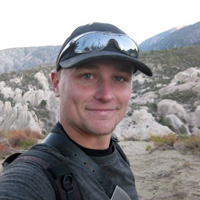 Range, Moisture, and Spatial Resolution Comparison of Fault Stratigraphy Using Hyperspectral ImageryBrendon Walker Friday, April 18th, 2014 |
| ABSTRACT
We examine three spectral ranges that correspond to the ranges of common hyperspectral cameras, and we assessed two different moisture content averages, all with the goal to determine the optimal range and usable potential of hyperspectral imagery on paleoseismic exposures, as most cameras are incapable of field testing due to portability and cost. For this study, we used a 60x60cm sample of faulted stratigraphy from the San Jacinto Fault Zone at Hog Lake near Anza, California and imaged it with a BEECHIS 12-bit hyperspectral camera. We obtained 320 narrow bands from 391.6 to 1000nm to represent the visible near-infrared (VNIR) region, and 400 bands from 1000nm to 2.4906nm to represent the short-wave infrared (SWIR) region. The image was corrected for unidirectional light and then segmented into three spectral ranges to represent the different ranges of cameras that are currently on the market; 400 to 1000nm, 900 to 1700nm, and 1000 to 2500nm. Running identical procedures through ENVI Classic, the relative reflectance values were processed through a supervised and unsupervised classification algorithm to directly compare the resulting images and analyze the fault features of the sample. We then compared the spatial resolution of the images to that of a higher spatial resolution image taken in 2006 from a study by Ragona et al., 2006. Many hyperspectral cameras exist today, but most are restricted by size and portability, cost, and spectral range and resolution. By using a single camera in a controlled environment that covers the ranges of most other cameras, we assessed the benefits of different hyperspectral ranges towards application on paleoseismic exposures, with the specific goal to decide on whether use of a single potential field camera is achievable with minimal loss of potential resolution, and to explore how moisture content can affect results in these types of studies, as the sediments in most paleoseismic exposures have significant moisture contents when first opened. |

